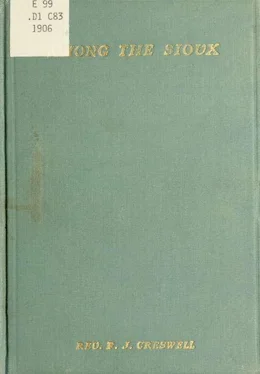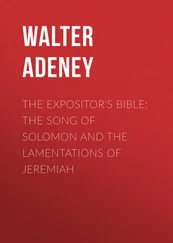Creswell, J.) - Among the Sioux - a story of the Twin Cities and the two Dakotas
Здесь есть возможность читать онлайн «Creswell, J.) - Among the Sioux - a story of the Twin Cities and the two Dakotas» весь текст электронной книги совершенно бесплатно (целиком полную версию без сокращений). В некоторых случаях можно слушать аудио, скачать через торрент в формате fb2 и присутствует краткое содержание. Жанр: Старинная литература, на английском языке. Описание произведения, (предисловие) а так же отзывы посетителей доступны на портале библиотеки ЛибКат.
- Название:Among the Sioux : a story of the Twin Cities and the two Dakotas
- Автор:
- Жанр:
- Год:неизвестен
- ISBN:нет данных
- Рейтинг книги:5 / 5. Голосов: 1
-
Избранное:Добавить в избранное
- Отзывы:
-
Ваша оценка:
- 100
- 1
- 2
- 3
- 4
- 5
Among the Sioux : a story of the Twin Cities and the two Dakotas: краткое содержание, описание и аннотация
Предлагаем к чтению аннотацию, описание, краткое содержание или предисловие (зависит от того, что написал сам автор книги «Among the Sioux : a story of the Twin Cities and the two Dakotas»). Если вы не нашли необходимую информацию о книге — напишите в комментариях, мы постараемся отыскать её.
Among the Sioux : a story of the Twin Cities and the two Dakotas — читать онлайн бесплатно полную книгу (весь текст) целиком
Ниже представлен текст книги, разбитый по страницам. Система сохранения места последней прочитанной страницы, позволяет с удобством читать онлайн бесплатно книгу «Among the Sioux : a story of the Twin Cities and the two Dakotas», без необходимости каждый раз заново искать на чём Вы остановились. Поставьте закладку, и сможете в любой момент перейти на страницу, на которой закончили чтение.
Интервал:
Закладка:
dians of Little Crow's band, but also doing great good to the white settlers, who were then gathering around the future Capital City of Minnesota. Here in 1848, he organized an Indian church of eight members. It increased to fifteen members, in 1851, when the Indians were removed.
Then followed the treaty of 1851, which was of great import, both to the white man and to the red man. By this treaty, the fertile valley of the Minnesota was thrown open for settlement to the whites. This took away from the vSioux their hunting-grounds, their cranberry marshes, their deer-parks and the graves of their ancestors. So the Dakotas of the Mississippi and lower Minnesota packed up their teepees, their household goods and gods, some in canoes, some on ponies, some on dogs, some on the women, and slowly and sadly took up their line of march towards the setting of the sun.
No sooner did the Indians move than Dr. Williamson followed them and established a new station at Yellow Medicine, on the West bank of the Minnesota river and three miles above the mouth of the Yellow-Medicine river. The first winter there, was a fight for life. The house was unfinished; a very severe winter set in unvisually early, the snows were deep and the drifts terrible; the supply-teams were snowed in; the horses perished, the provisions were abandoned to the wolves and the drivers reached home in a half-frozen condition. But God cared for His servants. In this emergency, the Rev. M. N. Adams, of Lac-qui-Parle, performed a most heroic act. In mid-v/inter, with the
thermometer many deg-rees below 5:ero, he hauled flour and other provisions for the missionaries, on a hand sled, from Lac-cini-Parle to Yellow Medicine, a distance cf thirty-two miles. The fish gathered in shoals, an unusual occurrence, near the mission and both the Indians and the missionaries lived throug-h that terrible winter. Here, an Indian church of seventeen members was organized by Dr. Williamson. It increased to a membership of thirty in the next decade.
In March, 1854, the mission houses at Lac-qui-Parle were destroyed by fire. A consolidation of the mission forces was soon after effected. Dr. Rigg's and other helpers were transferred from Lac-qui-Parle to a point two miles distant from Yellow Medicine and called Omehoo (Hazelwood). A comfortable mission home was erected. The native Christians remo\^d from I.ac-qui-Parle and re-established their homes at Hazelwood. A boarding school was soon opened at this point by Rev. M. N. Adams. A neat chapel was also erected. A church of thirty members was organized by Mr. Riggs. It grew to a membership of forty-five before the massacre. These were mainly from the the Lac-qui-Parle church which might be called the mother of all the Dakota churches.
There were now gathered around the mission stations, quite a community of young men, who had to a great extent, become civilized. With civilization came new wants—pantaloons and coats and hats. There was power also in oxen and wagons and brick-houses. The white man's axe and plow and hoe had
been introduced and the red man was learning to use them. So the external civilization went on.
But the great and prominent force was in the underlying education and* especially in the vitalizing and renewing powt>r of Christian truth. So far as the inner life was changed, civilized habits became permanent; otherwise they were shadows. Evangelization was working out civilization. It is doing its permanently blessed work even yet.
About this time occurred the formation of the Haz-elwood Republic.
This was a band of Indians somewhat advanced in civilization, who were organized chiefly by the efforts of Dr. Riggs, under a written constitution and by-laws. Their officers were a President, Secretary and three judges, who were elected by a vote of the membership for a term of two years each. Paul Maza-koo-ta-mane was the first president and served for tw^o terms. This was an interesting experiment, in the series of efforts, by the missionaries, to change this tribe of nomads from their roving teepee life to that of peiTnan-cnt dwellers in fixed habitations. The rude shock of savag.? warfare, which soon after revolutionized the whole Sioux nation, swept it away before its efficiency could be properly tested. Surely it was a novelty—an Indian band, regulated by written laws and governed by officers, elected by themselves for a temi of years. It now exists only in the memory of the oldest of the tribesmen or tlie missionaries.
In 1843, a new station was established at Traverse des Sioux (near St. Peter, Minnesota,) by the Rev.
.'o AMONG THE SIOUX.
Stephen R. Riggs. This station was doomed to a tragic history. July 15, 1843,, Thomas Longley, the favorite brother of Mrs. Mary Riggs, was suddenly swallowed up in the treacherous waters of the Minnesota and laid to rest under what his sister was wont to call the ''Oaks of weeping"—three dwarf oaks on a small knoll. In 1844, Robert Hopkins and his young bride> joined the workers here. In 1851, July 4, Mr. Hopkins was suddenly swept away to death by the fatal waves of the IMinnesota and his recovered body was laid to rest under the oaks where Thomas Longley had slept all alone for seven years. Thus the mission at Traverse des Sioux was closed by the messenger of death. It was continued, however, in the nearby frontier town of St. Peter, whose white settlers requested the Rev. M. N. Adams, one of the missionaries to the Sioux, to dcA'Cte his time to their spiritual needs. He complied and founded a white Presbyterian church and it is one of the strong Protestant organizations of Southern Minnesota.
In 1843, also the Pond brothers established a station at Oak Grove, twelve miles west of the Falls of St. Anthony. It was never abandoned. For many years it. was the center of beneficent influences to both races for miles around. It developed intO' the white Presbyterian church of Oak Grove, which still stands as a monument to the many noble qualities of its founder, Rev. Gideon Hollister Pond. On the Sabbath scores of his descendants worship within its walls. The surrounding community is composed largely of Ponds and their kindred. - .
In 1846, a mission was established at Red Wing by the Reverends J. ¥. Aiton and J. W. Hancock, and another in i860, at Red Wood by Rev. John P. Wil-Hamson.
In 1858, a church was organized at Red Wing with twelve members. This was swept away by the outbreak in 1862.
Dr. John P. Williamson, who was born in 1835, in one of the mission cabins on the shores of Lac-qui-Parle, who has spent his whole life among the Sioux Indians, and who with a singleness of purpose, worthy of the apostle Paul, has devoted his whole life to their temporal and spiritual uplift, thus vividly sketches missionary life among the Sioux in his boyhood days: ''Aiy first serious impression of life was that I was living under a great weight of something, and as I began to discern more clearly, I found this weight to be the all-surrounding overwhelming presence of heathenism, and all the instincts of my birth and culture of a Christian home set me at antagonism to it at every point.
'This feeling of disgust was often accompanied with fear. At times, violence stalked abroad unchallenged and dark lowering faces skulked about. Even when we felt no personal danger this incubus of sava^ff life all around weighed on our hearts. Thus it was day and night. Even those hours of twilight, which brood with sw^eet influences over so many lives, bore to us, on the evening air, the weird cadences of the heathen dance or the chill thrill of the war-whoop.
Ours was a serious life. The earnestness of our parents in the pursuit of their work could not fail to im-
■22 AMONG THE SIOUX.
press in some degree the children. The main purpose of Christianizing that people was felt in everything. It was like garrison life in time of war. But this seriousness was not ascetical or moroseful. Far from it. Those missionary- heroes were full of gladness. With all the disadvantages of such a childhood was the rich privilege of understanding the meaning of cheerful earnestness in Christian life."
Читать дальшеИнтервал:
Закладка:
Похожие книги на «Among the Sioux : a story of the Twin Cities and the two Dakotas»
Представляем Вашему вниманию похожие книги на «Among the Sioux : a story of the Twin Cities and the two Dakotas» списком для выбора. Мы отобрали схожую по названию и смыслу литературу в надежде предоставить читателям больше вариантов отыскать новые, интересные, ещё непрочитанные произведения.
Обсуждение, отзывы о книге «Among the Sioux : a story of the Twin Cities and the two Dakotas» и просто собственные мнения читателей. Оставьте ваши комментарии, напишите, что Вы думаете о произведении, его смысле или главных героях. Укажите что конкретно понравилось, а что нет, и почему Вы так считаете.












